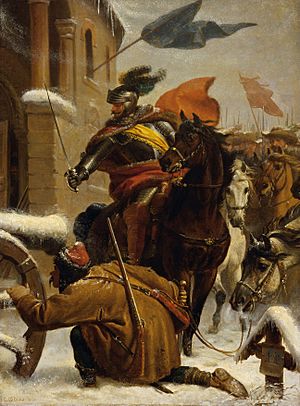Battle of Tuttlingen facts for kids
Quick facts for kids Battle of Tuttlingen |
|||||||
|---|---|---|---|---|---|---|---|
| Part of Thirty Years' War and the Franco-Spanish War (1635–59) |
|||||||
 Johann de Werth's Überfall bei Tuttlingen by Karl von Blaas (oil on canvas, 1866) |
|||||||
|
|||||||
| Belligerents | |||||||
| Commanders and leaders | |||||||
| Strength | |||||||
| 15,000-22,000 | 15,000-18,000 10 guns |
||||||
| Casualties and losses | |||||||
| 1,000 | 7,000-10,500 10 guns |
||||||
The Battle of Tuttlingen was a major fight during the Thirty Years' War and the Franco-Spanish War (1635–59). It happened on November 24, 1643, in Tuttlingen, which is now in Germany. The French army, led by Marshal Josias Rantzau, was surprised and defeated by forces from the Holy Roman Empire, Bavaria, and Spain. These forces were led by Franz von Mercy.
This battle was a big win for the Imperial-Bavarian-Spanish side. It caused the French army to almost disappear. The French government tried to keep this defeat a secret, so many people don't know about it today.
Contents
How the Battle Started
In early November 1643, the French army and their German allies, called the "Weimarans," were trying to take over Rottweil. They wanted to find safe places to stay for the winter along the Danube River near Tuttlingen.
They captured Rottweil on November 18. But their leader, Guébriant, was badly hurt during the attack and later died. A new commander, Rantzau, took over. However, many of the German officers didn't like him.
The French army had some smaller groups of soldiers spread out in nearby towns like Mühlingen and Möhringen. Meanwhile, the Imperial army, led by Mercy, got stronger with more soldiers joining them. Mercy saw that the French were not paying close attention. He convinced his generals to agree to a surprise attack on the French camp. To make sure the attack was a complete surprise, they approached from a direction the French didn't expect.
The Battle of Tuttlingen
On the afternoon of November 24, 1643, the attack began. A group of 2,000 cavalry (soldiers on horseback) led by Johann von Werth quickly attacked Möhringen. They easily defeated a French infantry (foot soldiers) group of 500 men.
At the same time, Bavarian dragoons (soldiers who could fight on horseback or on foot) captured the French guards near Tuttlingen. This allowed the Imperial forces to quickly take control of the French artillery (cannons) that were in the cemetery outside the town. Heavy snowfall helped hide their movements, making the surprise even bigger.
The French cavalry tried to escape. The captured French cannons were then used to fire at the remaining French infantry in Tuttlingen and Möhringen. The French soldiers, along with their commander Rantzau, gave up the next day without anyone else being killed. The fighting lasted about a day and a half. This was mostly because the French groups were spread out and disorganized, not because they fought back strongly. The 2,000 French soldiers in Rottweil surrendered a week later.
After the Battle
The Battle of Tuttlingen was a huge disaster for the French army. Most of Rantzau's army was destroyed. Only about 4,500 soldiers managed to escape back across the Rhine River.
Mercy's forces captured Rantzau and seven other French generals. They also took 9 colonels, 10 cannons, and thousands of French soldiers as prisoners. About 4,000 French soldiers were killed or wounded. This defeat greatly weakened the German allies of the French. The French army was pushed back to where it had been five years earlier. The French government tried to hide how bad this defeat was, which is why it's not as well-known today.
See also
 In Spanish: Batalla de Tuttlingen para niños
In Spanish: Batalla de Tuttlingen para niños
- List of battles
Sources
- Croxton, Derek. "The Prosperity of Arms Is Never Continual: Military Intelligence, Surprise, and Diplomacy in 1640s Germany." The Journal of Military History, Vol. 64, No. 4 (October 2000), pp. 981–1003.
Images for kids
-
Tutlingen - excerpt from Topographia Sueviae (Schwaben) by Matthäus Merian the Elder

